
There was a time when match predictions were all about gut feelings and expert guesses. But now, artificial intelligence (AI) is changing that game—literally. From scouting to injury prevention, predictive analytics in football is becoming the secret weapon for clubs that want to stay ahead.
What Is Predictive Analytics, Really?
Let’s break it down. Predictive analytics uses historical data, real-time stats, and machine learning to forecast future outcomes. In football, this could mean predicting a striker’s scoring probability in certain conditions, or anticipating when a player might pick up an injury.
I once had a chat with a data analyst from a Championship club who told me, “We can predict with 75% confidence which players will underperform after international duty—just from their fatigue and travel stats.” That blew my mind.
Smarter Decisions, On and Off the Pitch
Coaches today don’t just rely on their eyes—they rely on dashboards. Pre-match plans now include heatmaps, possession trends, and opponent weaknesses generated by AI systems. These insights help managers adjust tactics before kickoff and even during halftime.
Behind the scenes, recruitment departments are using AI to spot talent that traditional scouts might miss. A 19-year-old in Norway with perfect passing stats in freezing weather? AI has already flagged him.
Injury Prevention Gets a Boost
Injuries can ruin seasons—and careers. Predictive analytics helps clubs reduce this risk by monitoring players’ movements, workloads, and stress levels. If a pattern suggests a risk of muscle strain, the coach can act fast: rest the player, adapt training, or apply treatment early.
Top clubs now treat this tech as non-negotiable. After all, why react to injuries when you can prevent them altogether?
From Fans to Fantasy Football
And it’s not just clubs using AI. Broadcasters, betting platforms, and fantasy football apps now use predictive models to enhance fan engagement. Want to know the likelihood of your favorite midfielder getting an assist? There’s an algorithm for that.
This opens the door to a more interactive experience—where fans become analysts in their own right.
Conclusion: The Future Is Already Here
AI and predictive analytics aren’t science fiction—they’re football’s present and future. The clubs that embrace them are getting smarter, faster, and more efficient. Those that don’t? Well, they’re playing catch-up.
So next time you hear a commentator mention “expected goals” or see a substitute that seems random, remember: there might be a machine behind that decision—crunching the numbers in real time.